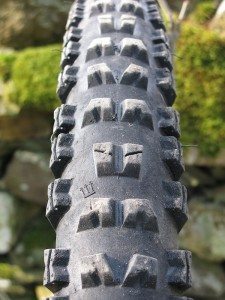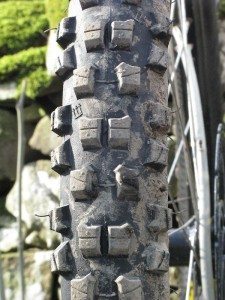Tires: Continental Rain King (aka Der Baron) 2.5, Continental Der Kaiser 2.5
Weight: 1275g
Compound: Black Chili
Intended Use: DH, Freeride
Rider: 6’2”, 208 lbs.
Test Location: Colorado Front Range (dry and rocky + wet spring)
Bike: Morewood Makulu, 203mm travel, Mavic 729 rims
Duration of Test: At least 30 days DH, each tire.

I was pretty excited to try the new Continental range of DH tires, since the claims about their “Black Chili” rubber compound are fairly bold, and their tread patterns don’t stick random knob in silly places.
Both Conti tires feature big, blocky side knobs that just hook up and grab once the bike is laid over, and a center line of knobs facing the correct direction—ramped leading edges and square braking edges. Neither has any goofy intermediate knobs, so the bike is able to roll up nicely onto the edge and carve very clean corners.
One thing to point out is that the profiles of these tires are very different. The Der Kaiser is more rounded, and the Rain King is more squared off. Because of this, I preferred the Der Kaiser on a wider rim. I would recommend at least a 32mm rim width, and I thought the 36mm Mavic EX729 gave the best profile to this tire.
The Rain King was less picky and I ended up riding it on 29mm wide rims, 32mm wide rims, and 36mm wide rims. While the profile did change through these rims, they were all in a happy place, from slightly rounded on the narrower rims to slightly flat on the wider rims. The rounded profile on the Der Kaiser really was not at home on a narrower rim (i.e. 28-29mm), and I had a really hard time finding the cornering knobs.
The width of the Continental 2.5 tires is right in the middle of the spectrum. Where a 2.5 Maxxis measures 2.3, and a Kenda or Schwalbe 2.35 or 2.5 measures true to size, the Continental 2.5 measures 2.4, which I was pleased with. While this is entirely subjective, they just “looked right” to me—maybe it was the “Goldilocks Syndrome.”
The Black Chili compound is the real deal. The tires wear extremely well compared to the soft equivalents Schwalbe Gooey Gluey, Vertstar/Maxxis 3C, and Super Tacky compounds. I saw similar wear on a Continental after 20-plus days that I would see on a Schwalbe or Maxxis after 5 days. I was routinely tossing tires at 30-40 days with Continental, when I throw away Schwalbe or Maxxis tires at 15-20 days of riding. Those savings add up quickly if you ride frequently.
The braking performance on both tires is exceptional for three reasons:
1) The rubber is soft enough to bite and grab and deform to the ground.
2) Continental was smart enough to not mess with the braking edge—keeping it square in both directions.
3) There aren’t any deep sipes (like there are on the Minion), so the braking edge stays fresher, longer. The braking edge on the Minion rounds and wears after only a few runs.

The Continental tires are simply square and flat in both directions. Both of these tires slow you down, quickly, without losing traction. It was really quite refreshing and impressive. The trails I ride most often are very steep, dry, loose, tight, and feature a lot of quick-catch berms which essentially require constant speed management. With a Minion, it would be normal to lock your rear wheel five times a run, but with the Continentals, the braking performance was such that I would lock up the rear wheel one or two times a day. I’m really happy with this trait.
The Rain King tread is more blocky, with less leading edge ramp than the Der Kaiser. But, the Der Kaiser has a taller knob height and they are packed together tighter along the center of the tire.
The Rain King was most at home in true hardpack, loose over hardpack/decomposed granite, loose rocks, and softer dirt. The tire really shined in blown out, destroyed, dry conditions. The slightly lower knob height still worked fine in really wet soil, as the knobs are spaced wide enough apart to clear muck fairly well, but was not ideal.
The Der Kaiser tread performed very well all around, doing admirably in dry, dusty, rocky, and wet conditions. It was slightly more at home in the wetter, loamier, softer conditions, or when it was really dusty or loose. Here, the taller knob height could penetrate into the trail surface. It did take me a while to find the cornering point on this tire in off-camber, fall-away turns. You just had to trust that the tire would keep going over and find the cornering row.
The Der Kaiser worked really well when conditions were a little more extreme (i.e. very dusty, muddy, very loose/blown out), while the Rain King handled the middle ground (i.e. hardpack, rocky, etc.) a little better. I would suggest both tires without question. I personally preferred the Rain King due to its more square profile and resulting cornering ability, which matched my riding style. It also engaged two wheel drifts really well, and I never felt that it was costing me significant performance in the more extreme conditions where the Der Kaiser was mildly better.
It should be noted that if you run tubes, it is likely you will flat more with the Continental DH tires than with any other tire on the market. I experimented with pressure, and finally determined I had to run 35psi rear, 32psi front at all times. I diligently check pressure before every ride, or I would flat immediately. The tires rode great at this pressure, but I like a firmer tire and slightly softer suspension setup anyhow, so this was not a problem. But flatting is an annoyance that I prefer to avoid. 34/32 PSI to start, and go from there, or run burly DH tubes.
I did not set these up tubeless, but my understanding is that they work well with 823’s and the like. I should add that the casing of the tire proved to be plenty tough. I do see cuts in my Minions regularly, and never had an issue with the Continental casing getting sliced on the rocks. I think they would hold up well tubeless, and that would alleviate the pinch flat issue. The casing is rather stiff due to the high 180tpi construction, but it is not reinforced with butyl, so once it starts to fold, there is nothing to stop it, and it pinches the tube.
Summary: For me, in the dry, dusty, Colorado front range, the Rain King was the preference. If I lived higher in Colorado, where my tires would see more soil/dirt, then the Der Kaiser would be my preference. Both tires ride excellently. Just be sure to check tire pressure before every ride.
